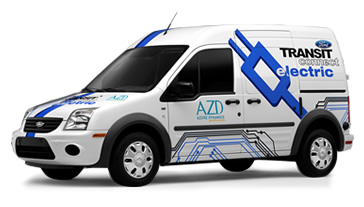Migration to Alternative Fuels and Powertrains
In this section

Battery Electric Vehicles (BEVs)
Transit Connect Electric
BEVs use no gasoline; they are powered by a high-voltage electric motor and battery pack. In 2010, Ford introduced its first BEV, the Transit Connect Electric. In 2011, Ford will introduce the Focus Electric with a planned range of 100 miles on a charge and half the recharge time of our competitors’ BEVs.
2007Near TermBegin migration to advanced technology |
2011Mid TermFull implementation of known technology |
2020–2030Long termContinue deploying advanced powertrains and alternative fuels and energy sources |
|---|---|---|
Battery Electric Vehicles (BEVs) |
||
Ford has announced an expanded, comprehensive electric vehicle strategy aligned with growing public interest in advanced technologies that reduce the use of gasoline and diesel. Our approach to electrification tackles commercial issues such as battery cost, standards development and infrastructure deployment. In addition, strategic partnerships are an important part of this new approach. We are working with partners to develop appropriate battery cells, collaborate on government policy and define the infrastructure needed to speed the commercialization and acceptance of electric vehicles. To read more about our approach, please see Electrification: A Closer Look.
Battery electric vehicles do not have an internal combustion engine and do not use any on-board gasoline. Instead, they use a high-voltage electric motor, which gets its power from a high-voltage battery pack charged by plugging into a standard 110-volt or 220-volt outlet in the U.S., or a 230-volt outlet in Europe.
In 2010 we introduced a BEV version of the Ford Transit Connect light commercial van, for use by small business owners and fleet customers in the U.S. This vehicle is produced in partnership with Azure Dynamics, a world leader in the development and production of hybrid electric and battery electric commercial vehicles.
In late 2011 we will launch an all-electric passenger sedan, the Ford Focus Electric, based on the all-new Focus. This car has a target driving range of 100 miles on a single charge of its lithium-ion high-voltage battery. We are targeting 19 initial markets with this vehicle. We will be ready to expand to new markets and ramp up to higher volumes as the infrastructure develops and customer demand grows.
A full recharge of the Focus Electric is expected to take three to four hours at home with the 240-volt charge station – half the charging time required by competitors’ battery electric vehicles. As fast-charge technology standards are developed, Ford’s Focus Electric will be designed to take advantage of this capability.
The Focus Electric, as well as Ford’s other electrified vehicles including HEVs and PHEVs, will use lithium-ion batteries. These batteries provide better performance, require less space and weigh less than the nickel metal hydride batteries used in current hybrid electric vehicles. The Focus Electric’s advanced lithium-ion battery system was engineered by Ford in cooperation with the supplier LG Chem. It uses an advanced, active liquid cooling and heating system to precondition and regulate the temperature, which helps to maximize battery life and fuel-free driving range.
The Focus Electric will include an enhanced version of MyFord Touch™ – Ford’s new driver interface technology – that will give drivers information to help maximize driving range, plan the most eco-friendly route and manage the battery recharge process.
Drivers will also be able to manage their Focus Electric remotely using the Ford-developed MyFord Mobile app. This system enables customers to get instant vehicle status information, perform key functions remotely, monitor the car’s state of charge and current range, get alerts when it requires charging, remotely program charge settings and download vehicle data for analysis from a smartphone or secure Ford website. For more information on the Focus Electric driver information systems and mobile controls, please see Living the Electric Lifestyle.
The Focus Electric will also work with Value Charging (powered by Microsoft®), a home energy management system that works exclusively with Ford electric vehicles to help customers reduce their electricity costs by taking advantage of off-peak or other reduced rates from their utility, without a complicated set-up process. For more information on this technology, please see Electrification: A Closer Look.
We are also introducing all-electric vehicles in Europe. We will launch the Ford Transit Connect Electric in Europe in 2011 followed by the Ford Focus Electric in 2012. In preparation for these launches, Ford is participating in BEV test trials in the UK and Germany with Transit Connect Electrics as well as early Focus Electrics, to test the technology’s suitability in real-world situations.
Ford is actively working to help develop standards to ensure that plug-in and charge stations work for all BEVs and to ensure that the technology is reliable and durable for customers. In North America, the Society of Automotive Engineers, with Ford’s participation, successfully aligned all major original equipment manufacturers on a standard charge connector and communication protocol, enabling all plug-in vehicles to use common charge points. This will be a key enabler for adoption in North America; the same connector is under consideration in Europe and China.
- Overview
- Economy Data
- Environment Data
- Society Data
